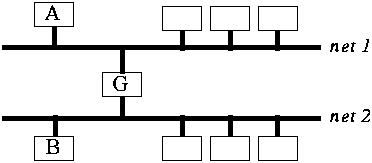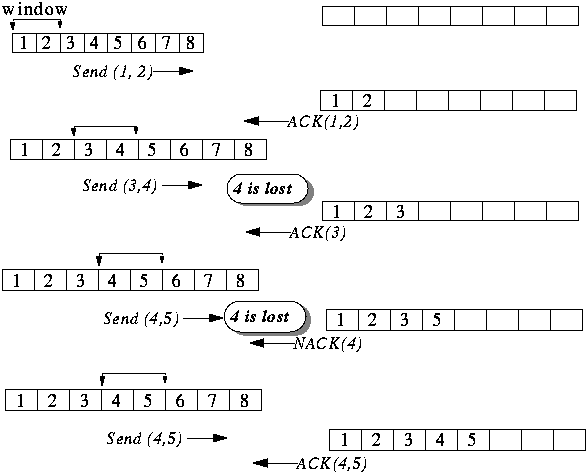
Gateways
Wide Area Networks (WAN) are categorised by the following:
Between LAN and WAN, there is also the Metropolitan Area Network (MAN)
Internet Layering
Layer Example
----- -------
-----------------
| Application | FTP, Telnet, SMTP, X-Windows, MIME, HTTP
-----------------
| Transport | UDP, TCP, TP4, Routing
-----------------
| Internet | IGMP, IP, CLNP
-----------------
| Subnetwork | Ethernet, X.25, FDDI, Token Ring
-----------------
| Data Link | HDLC, PPP, SLIP
-----------------
| Physical | RS-232, V.35, Fiber Optic
-----------------
Network Layer - IP (Internet Protocol)
Gateways and Routing

Gateways
Routing using the Internet Protocol
Solution: Don't use B's Ethernet address. Use another name for B (it's IP address) and provide a translation table from IP addresses to Ethernet addresses (called a routing table).
IP Problems and Solutions
Local Solution: To map from IP to Ethernet, use Address Resolution Protocol (ARP - RFC 826).
ARP broadcasts "What's the Ethernet address for IP address X?" For all non-local machines, send to default router (gateway).
Gateway Solution: To properly forward a packet, gateways keep up to date routing tables. Gateways exchange tables with neighbor gateways frequently (e.g. once a minute).

Gateway Memory
Solution 1: Provide end-to-end flow control. Could be very slow if there are a lot of links.
Solution 2: Let sources reserve resources (memory, bandwidth) on path, make well behaved applications that won't use more than they reserve. Such protocols are called quality of service (QOS) protocols.
Solution 3: Just drop the packets.
Summary: IP properties
Transport Layer - UDP and TCP UDP and TCP are two transport-layer protocols used in TCP/IP.
UDP (User Datagram Protocol)
UDP adds port number (16 bit identifier) to packet to indicate destination process
Higher level protocols must then take care of retransmission, divide and reassemble packets, flow control, congestion avoidance, etc.
TCP (Transmission Control Protocol)
If ACK not received in a little while (the retransmission timeout, or RTO), resend segment.
Performance improvements

Perfomance Improvemnt
Flow Control
If network is under-utilized, speed up send rate.
TCP Model

TCP Model
Receiver gets stream in order using read() system calls
TCP Flow control
When network is congested, must reduce rate at which we're sending data.
Two states:congestion avoidance and slow start.